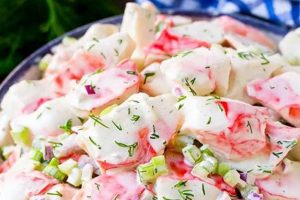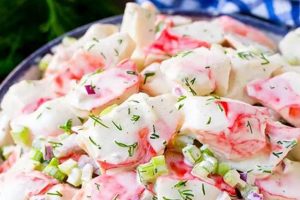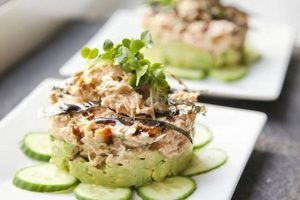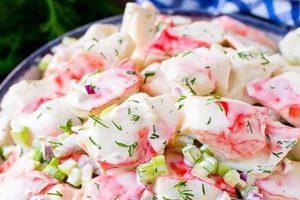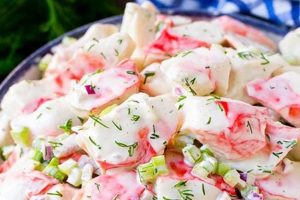A nutritious crab salad emphasizes fresh ingredients and lean preparation methods. For example, it might substitute Greek yogurt for mayonnaise or incorporate whole grains like quinoa or brown rice. Such recipes often feature an abundance of vegetables, adding both flavor and dietary fiber.
Light yet satisfying, a health-conscious approach to this classic dish offers significant nutritional benefits. It can be a good source of lean protein and omega-3 fatty acids, contributing to a balanced diet. Furthermore, the inclusion of fresh produce boosts vitamin and mineral intake. While traditional versions may be calorie-dense, contemporary variations prioritize healthier fats and lower sodium content, aligning with modern dietary guidelines.
The following sections will explore specific ingredient choices, preparation techniques, and variations to create a delicious and wholesome crab salad.
Tips for a Healthier Crab Salad
Creating a nutritious and flavorful crab salad involves careful ingredient selection and mindful preparation. These tips offer guidance on maximizing flavor and nutritional value.
Tip 1: Opt for fresh crab meat. Canned crab can be higher in sodium and may contain preservatives. Fresh crab offers superior flavor and nutritional benefits.
Tip 2: Choose a light base. Instead of relying solely on mayonnaise, consider using Greek yogurt, light mayonnaise, or a combination of both. This reduces fat and calories while adding protein.
Tip 3: Incorporate whole grains. Add cooked quinoa, brown rice, or farro for increased fiber and complex carbohydrates, creating a more substantial and satisfying salad.
Tip 4: Load up on vegetables. Celery, bell peppers, red onion, and chopped fresh herbs contribute essential vitamins, minerals, and antioxidants, enhancing both flavor and nutritional value.
Tip 5: Season thoughtfully. Fresh lemon juice, Dijon mustard, and a pinch of cayenne pepper offer vibrant flavor without excessive salt or reliance on processed seasonings.
Tip 6: Be mindful of portion sizes. Even healthy versions should be enjoyed in moderation as part of a balanced diet.
Tip 7: Chill thoroughly. Allowing the salad to chill enhances the flavors and allows the ingredients to meld.
By following these guidelines, one can create a crab salad that is both delicious and supportive of a healthy lifestyle.
These tips provide a foundation for creating a nutritious and flavorful crab salad. Experiment with different combinations of ingredients and seasonings to discover your preferred version.
1. Fresh Crab Meat
Fresh crab meat is paramount to a healthy and flavorful crab salad. Its quality directly impacts the nutritional value, taste, and overall culinary experience. Understanding its importance and selecting it carefully is crucial for a successful dish.
- Nutritional Value
Fresh crab provides high-quality protein and essential nutrients like omega-3 fatty acids, vitamin B12, and selenium, supporting overall health. These nutrients contribute to a balanced diet and are often lacking in processed or canned alternatives. Choosing fresh crab maximizes these nutritional benefits.
- Flavor Profile
Fresh crab offers a delicate, sweet flavor that enhances the overall taste of the salad. Canned crab often has a stronger, fishier taste due to processing and preservatives. The natural sweetness of fresh crab allows for a cleaner flavor profile, complementing other fresh ingredients in the salad.
- Texture and Appearance
Fresh crab meat has a delicate, flaky texture that contrasts pleasantly with the other ingredients in the salad. Canned crab can be mushy or stringy. The visual appeal of fresh, lump crab meat elevates the presentation of the dish, making it more appetizing.
- Sodium Content
Fresh crab is naturally lower in sodium than canned varieties. Excessive sodium intake can contribute to various health issues. Using fresh crab allows for better control over sodium levels in the salad, aligning with healthy eating guidelines.
The choice of fresh crab meat significantly impacts the overall quality and healthfulness of the salad. Prioritizing fresh crab contributes not only to a superior taste and texture but also aligns with a nutritionally conscious approach to meal preparation. By understanding the nuances of selecting and incorporating fresh crab, one can elevate a simple crab salad to a truly delectable and healthful culinary experience.
2. Reduced-fat Mayonnaise
Reduced-fat mayonnaise plays a crucial role in creating a healthier crab salad. Traditional mayonnaise, while contributing a creamy texture, is high in saturated fat and calories. Substituting reduced-fat mayonnaise significantly lowers the overall fat content without drastically compromising the desired creaminess. This substitution directly impacts the nutritional profile of the salad, making it a more healthful option. For example, replacing one cup of regular mayonnaise with a reduced-fat version can save approximately 800 calories and 90 grams of fat. This reduction contributes to weight management and cardiovascular health.
Furthermore, the use of reduced-fat mayonnaise allows for greater flexibility in incorporating other healthy ingredients. The lower fat content provides space, calorically, to add more nutrient-rich components like vegetables and whole grains without making the salad overly heavy or calorie-dense. This creates a more balanced and satisfying meal, rich in vitamins, minerals, and fiber. For instance, one might add chopped bell peppers, celery, and quinoa to a crab salad made with reduced-fat mayonnaise, boosting its nutritional value without significantly increasing the overall calorie count.
Reduced-fat mayonnaise offers a practical and effective strategy for creating a crab salad that aligns with dietary goals without sacrificing flavor or texture. While challenges exist in finding a reduced-fat option that perfectly mimics the flavor and consistency of full-fat mayonnaise, many acceptable alternatives are available. Selecting a high-quality reduced-fat mayonnaise, perhaps one enriched with olive oil or avocado oil, can enhance both the nutritional profile and the sensory experience of the salad. This mindful substitution empowers individuals to enjoy a classic dish in a way that supports their overall health and well-being.
3. Ample Vegetables
The inclusion of ample vegetables is integral to a healthy crab salad recipe. Vegetables contribute significantly to the nutritional value, flavor profile, and textural complexity of the dish. Their presence elevates the salad from a protein-centric dish to a more balanced and nutrient-rich meal. Cruciferous vegetables like finely chopped broccoli or shredded Brussels sprouts offer a boost of antioxidants and fiber, promoting digestive health and reducing the risk of chronic diseases. Water-rich vegetables such as cucumbers and bell peppers contribute hydration and essential vitamins while adding a refreshing crunch. The diverse array of colors in vegetables also enhances the visual appeal of the salad.
The impact of incorporating ample vegetables extends beyond basic nutrition. The added fiber promotes satiety, contributing to portion control and weight management. The lower caloric density of vegetables compared to other salad components, such as mayonnaise or crab meat, allows for a larger volume of food without excessive caloric intake. For example, adding a cup of chopped celery and bell peppers to a crab salad increases its volume and nutritional value while keeping the calorie count relatively low. This strategic addition of vegetables contributes to a more satisfying and less calorie-dense meal, supporting healthy eating habits. Furthermore, the vibrant flavors and textures of vegetables complement the delicate flavor of crab meat, creating a more complex and enjoyable culinary experience.
In summary, the integration of ample vegetables is crucial for optimizing the nutritional value and overall appeal of a healthy crab salad. Vegetables provide essential vitamins, minerals, antioxidants, and fiber, contributing to a balanced and satisfying meal. Their inclusion supports healthy eating habits, promotes satiety, and enhances the sensory experience of the dish. Challenges may include balancing flavor profiles and maintaining desired texture; however, careful selection and preparation of vegetables overcome these obstacles, resulting in a flavorful and healthful crab salad.
4. Whole Grains
Whole grains represent a valuable addition to a health-conscious crab salad, offering nutritional benefits that complement the other ingredients. Their inclusion contributes to a more balanced and satisfying meal, aligning with dietary guidelines that emphasize whole, unprocessed foods. Incorporating whole grains enhances the nutritional profile and culinary experience of the salad.
- Enhanced Nutritional Value
Whole grains provide complex carbohydrates, fiber, and essential micronutrients often lacking in refined grains. For example, quinoa offers a complete protein source, while brown rice provides magnesium and selenium. These nutrients contribute to sustained energy levels, digestive health, and overall well-being, complementing the protein and healthy fats from the crab.
- Increased Satiety
The fiber content in whole grains promotes satiety, contributing to feelings of fullness and potentially aiding in portion control. This can be particularly beneficial in salads, which sometimes lack the bulk and fiber necessary for a satisfying meal. The inclusion of whole grains like farro or barley creates a more substantial and satisfying salad, reducing the likelihood of overeating.
- Improved Textural Complexity
Whole grains introduce textural variety to the crab salad, contrasting with the delicate texture of the crab meat and the crispness of vegetables. The nutty flavor and chewy texture of cooked wild rice, for instance, adds depth and interest to the salad, enhancing the sensory experience. This textural contrast makes the salad more appealing and enjoyable.
- Versatile Culinary Applications
Numerous whole grains can be incorporated into crab salad, offering flexibility and variety. Quinoa, brown rice, farro, barley, and freekeh each possess unique flavor profiles and textures, allowing for customization based on personal preferences. This versatility ensures that individuals can find a whole grain that complements their preferred flavor combinations and culinary style.
The integration of whole grains into a crab salad transforms it into a more complete and nutritious meal. The added fiber, complex carbohydrates, and micronutrients contribute to a balanced nutritional profile, while the enhanced texture and flavor elevate the culinary experience. By thoughtfully selecting and preparing whole grains, one can create a crab salad that is both delicious and supportive of a healthy lifestyle. This approach exemplifies how mindful ingredient choices can transform a simple dish into a powerhouse of nutrition and flavor.
5. Minimal Processing
Minimal processing is a cornerstone of a healthy crab salad recipe. It prioritizes the use of fresh, whole ingredients and limits the inclusion of processed foods, additives, and excessive sodium. This approach preserves the natural flavors and nutrients of the ingredients, contributing to a healthier and more flavorful dish. Minimally processed crab salads align with dietary recommendations for whole food consumption and reduced intake of processed foods, which are often linked to various health concerns.
- Fresh Crab Meat Selection
Opting for fresh crab meat over canned or imitation varieties exemplifies minimal processing. Fresh crab meat typically contains fewer additives and preservatives and offers a superior flavor profile. Canned crab, conversely, often contains added salt and preservatives. Imitation crab meat, a highly processed product made from surimi (often pollock), contains fillers, starches, and artificial flavorings. Choosing fresh crab meat maximizes nutritional value and minimizes exposure to unwanted additives.
- Homemade Dressings
Preparing dressings from scratch allows for control over ingredients and minimizes the use of processed components commonly found in bottled dressings, such as added sugars, unhealthy fats, and artificial flavors. A simple vinaigrette made with olive oil, lemon juice, and herbs provides a flavorful and healthful alternative to processed dressings. This practice empowers individuals to select high-quality ingredients and tailor the flavor profile to their preferences.
- Whole Grain Incorporation
Using whole grains like quinoa or brown rice instead of refined grains aligns with minimal processing principles. Whole grains retain their bran and germ, which contain valuable fiber and nutrients often removed during refining processes. This choice contributes to increased fiber intake, promoting digestive health and satiety. Refined grains, such as white rice, lack these beneficial components and offer less nutritional value.
- Emphasis on Fresh Vegetables
Incorporating an abundance of fresh vegetables, rather than relying on pre-chopped or pre-packaged options, minimizes exposure to potential preservatives and additives. Fresh vegetables offer superior flavor and retain more nutrients. Pre-cut vegetables, while convenient, may be treated with preservatives to extend shelf life, potentially diminishing their nutritional value and introducing unnecessary additives.
By prioritizing minimally processed ingredients, a crab salad becomes more than a simple dish; it evolves into a testament to healthful eating. The emphasis on fresh, whole ingredients maximizes nutritional value, reduces exposure to additives and preservatives, and enhances the natural flavors of the components. Minimal processing elevates the crab salad from a convenient meal to a culinary expression of well-being, aligning with a health-conscious lifestyle. This approach benefits not only individual health but also promotes sustainable food practices by prioritizing whole, unadulterated ingredients.
Frequently Asked Questions
This section addresses common inquiries regarding healthy crab salad preparation and consumption.
Question 1: What is the best type of crab meat for a healthy crab salad?
Fresh lump crab meat offers the best flavor and nutritional value. It is typically lower in sodium than canned varieties and avoids the fillers and additives present in imitation crab.
Question 2: How can saturated fat be reduced in crab salad?
Substituting plain Greek yogurt or reduced-fat mayonnaise for full-fat mayonnaise significantly reduces saturated fat content. Avocado can also contribute a creamy texture with healthier fats.
Question 3: Can crab salad be part of a weight-management plan?
Crab salad can be incorporated into a weight-management plan when prepared with healthy ingredients and consumed in appropriate portions. Focus on fresh ingredients, lean protein, and fiber-rich vegetables.
Question 4: What are some healthy additions to enhance the nutritional value of crab salad?
Chopped vegetables like bell peppers, celery, and red onion add vitamins, minerals, and fiber. Whole grains such as quinoa or brown rice contribute complex carbohydrates and additional nutrients.
Question 5: How should crab salad be stored, and what is its shelf life?
Store crab salad in an airtight container in the refrigerator for up to three days. Ensure the salad is thoroughly chilled before consumption. Discard any salad that develops an off odor or appearance.
Question 6: Are there any specific health risks associated with consuming crab salad?
Individuals with shellfish allergies should avoid crab salad. Undercooked or improperly stored crab salad can pose a risk of foodborne illness. Pregnant individuals should consult dietary guidelines regarding safe seafood consumption.
Mindful ingredient selection and proper storage are crucial for maximizing the health benefits and minimizing potential risks associated with consuming crab salad.
This concludes the frequently asked questions section. The following section will offer a selection of healthy crab salad recipes.
Conclusion
Exploration of a health-conscious approach to crab salad reveals the importance of fresh ingredients, mindful preparation, and balanced nutritional profiles. Prioritizing fresh crab meat over canned or imitation versions maximizes flavor and nutritional value. Incorporating reduced-fat mayonnaise, ample vegetables, and whole grains contributes to a dish rich in lean protein, fiber, vitamins, and minerals. Minimizing processed ingredients and additives further enhances the healthfulness and taste of the salad. Understanding these key aspects empowers individuals to create a crab salad that supports overall well-being.
The potential of a simple crab salad to become a nutritious and satisfying meal underscores the transformative power of mindful culinary practices. By embracing fresh, whole ingredients and prioritizing balanced nutrition, individuals can elevate this classic dish to a culinary expression of health and well-being. This approach encourages a shift toward more conscious food choices, fostering a deeper appreciation for the connection between food and health.

